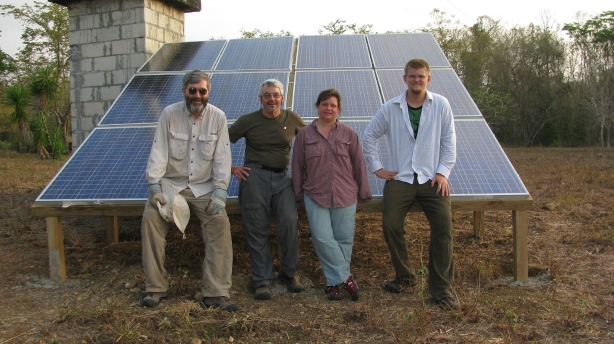COVER STORY SIDEBAR
Alum Jim Moore likes to tinker and build -- and to help students do the same
The way Jim Moore '62 sees it, there's just no substitute for learning by doing -- and no satisfaction like finding an answer that isn't in a textbook.
When he was an undergraduate in electrical engineering, Moore worked with professor Ralph Bolgiano Jr. solving technical problems and calibrating instruments at the old radio astronomy lab next to the Tompkins County Airport. He also worked for now-retired professor Simpson "Sam" Linke, devising a means to interrupt large DC currents.

From left, Professor David Wink Winkler, Jim Moore '62, his daughter Lori Prichard, and biology major Tom Johnson '10 after installing a solar array to power equipment that will monitor the food supply for birds at Hill Bank Field Station in northern Belize.
"I like to tinker and build stuff," says Moore, who holds eight patents. "I got more out of that than any of the courses I took."
Moore went on to a successful career with his family's company, Moore Products Co./Moore Process Automation Solutions, until its acquisition by Siemens Energy and Automation Inc. in 2000. When he wanted to do something philanthropic, funding undergraduate research projects seemed like the perfect match.
Moore has supported undergraduate research at Cornell for more than 20 years through the Moore Undergraduate Research Fund, which aids several engineering students each year. Goodwin "Win" Wharton '10 is one recent beneficiary.
During the summer of 2008, Wharton spent two weeks in Greece, working in the field with earth and atmospheric sciences associate professor Christopher Andronicos. Wharton's goal was to identify active faults and the principal stress axes in a 900-square-kilometer area, information that may lead to an improved ability to predict earthquakes.
"Win's experience is fairly typical of how I've worked with students," Andronicos explains. "During the summer we go into the field, I provide some training, and together we collect data and do geologic maps. When we come back, they use computers to turn their data into a product."
Wharton and Andronicos used a Brunton surveying compass to measure the "strike" and "dip" that describe the orientation of a plane in three-dimensional space. They noted these measurements in field notebooks, identifying each location with a hand-held global positioning device. They talked geology all day, every day, as they gathered data. In the evenings they camped alongside 17 archaeology, architecture and classics students from France, Serbia, Bulgaria and the United States -- including several from Cornell -- at a field camp run by retired Cornell classics professor John Coleman.
Says Wharton: "I'm more engaged in what I'm studying. A longer-term project with greater depth is a fantastic thing."
Moore has also supported the work of professor David W. Winkler in ecology and evolutionary biology, whose projects involve setting up environmental sensors and remotely monitoring bird nesting sites in Ithaca, Belize and other locations.
Occasionally, when Moore funds summer stipends for undergraduates, he pitches in to help. For example, he helped to design an off-grid solar webcam for nesting sites, and in Belize he worked with Winkler installing a solar array and 500 pounds of rechargeable batteries to power a large "bug sucker" -- a device that pulls insects out of the air and traps them in an alcohol-filled bottle so that field scientists can monitor the food supply for birds.
"That stuff, it's really fun getting involved in the engineering aspect of it," he says.
It's no surprise, then, that Moore identifies most with students who want to get into the field and put their knowledge to work on practical problems.
"What I'm looking for is real hands-on," Moore says. "I think the Cornell students are a cut above many other students in terms of hands-on knowledge."